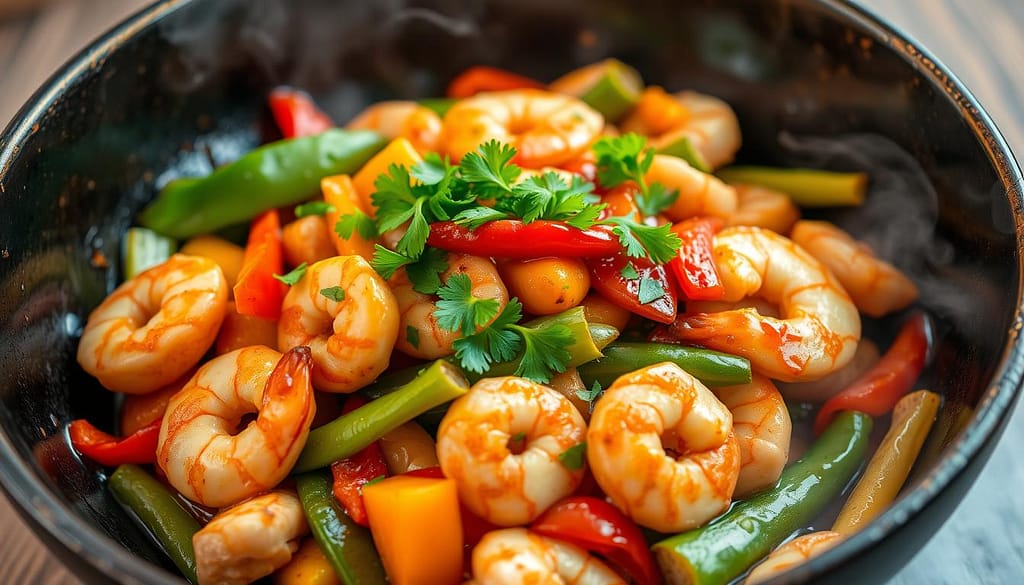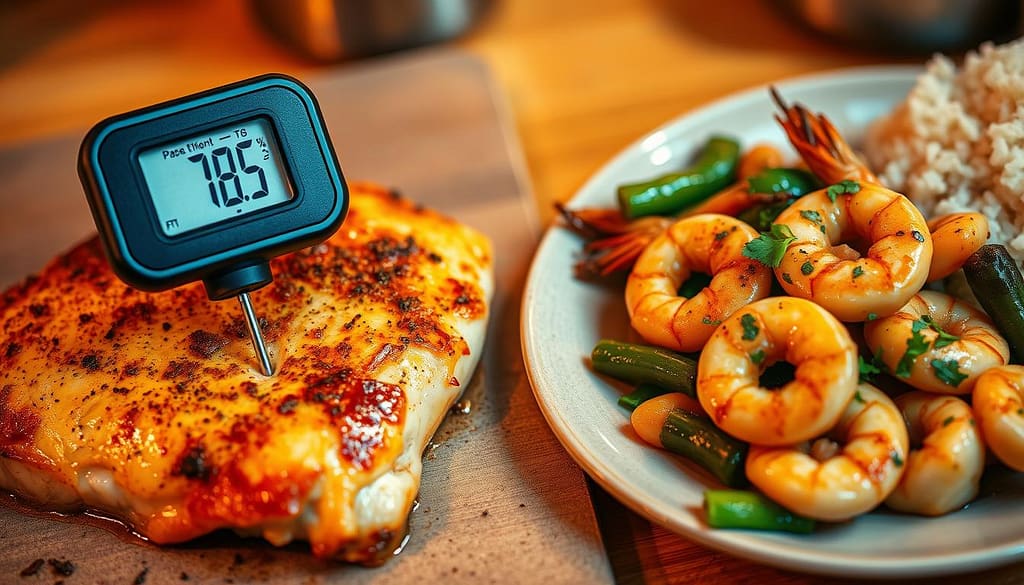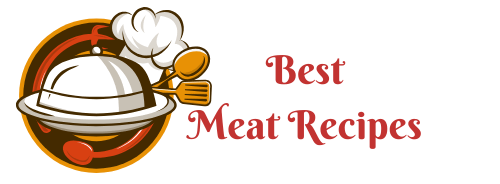Chicken and Shrimp Dishes: Flavorful Recipes to Try
When chicken and shrimp come together in the kitchen, magic happens. These recipes turn simple meals into special dining moments. They’re perfect for busy people or those who love to cook.
Chicken and shrimp are incredibly versatile. You can make spicy Cajun dishes or delicate Asian stir-fries. With just six ingredients, you can make meals that wow everyone.
Cooking these dishes is more than just about taste. It’s about creating memories. Imagine cooking shrimp and chicken together, filling your kitchen with amazing smells. These recipes are more than food; they’re a way to share flavors and traditions.
Next, we’ll explore techniques, recipes, and tips for cooking chicken and shrimp. Get ready to improve your cooking and find new flavors to love!
Table of Contents
Introduction to Dual-Protein Culinary Delights
Exploring the world of cooking opens up exciting possibilities. Combining creates a dynamic duo. This duo transforms simple meals into extraordinary dining experiences. These proteins add unique flavors, textures, and nutritional benefits to your kitchen.
Combining proteins is not just about taste. It’s also a smart nutritional strategy. Let’s dive into the delicious world of dual-protein cooking!
Benefits of Combining Poultry and Seafood
- Balanced nutritional profile
- Enhanced flavor complexity
- Diverse texture experience
- Increased protein intake
Nutritional Value and Protein Content
Your body will thank you for this protein-packed combination. Chicken has 31g of protein per 100g, while shrimp has 24g. The nutritional breakdown shows interesting differences:
- Chicken: 165 calories per 100g
- Shrimp: 99 calories per 100g
- Chicken fat content: 3.6g per 100g
- Shrimp fat content: Just 0.3g per 100g
“Variety is the spice of life, and in culinary arts, it’s also the key to nutrition!” – Professional Chef
Popular Cooking Methods Overview
Versatility is key with these incredible proteins. Whether you’re stir-frying, grilling, or baking, chicken and shrimp adapt well. Each method brings out unique flavors and textures, enhancing your culinary skills.
Mastering these proteins means understanding their cooking needs and how they complement each other. From quick weeknight meals to impressive dinner parties, chicken and shrimp offer endless possibilities for creative cooking.
Essential Ingredients and Kitchen Tools
To make tasty chicken and shrimp dishes, you need the right ingredients and tools. A well-stocked pantry and good cooking gear are key. They make cooking these flavors easy.
Must-Have Pantry Ingredients
- Cajun seasoning blend
- Olive oil
- Garlic powder
- Onion powder
- Red pepper flakes
- Brown sugar
- Italian seasoning
Choosing top-notch seasonings and spices is crucial. They turn a simple meal into a memorable one.
Essential Kitchen Tools
| Tool | Purpose |
|---|---|
| Cast iron skillet | Even heat for perfect searing |
| Instant-read thermometer | Guarantees safe cooking temperatures |
| Sharp chef’s knife | For precise cutting |
| Large cutting board | Safe space for handling ingredients |
“The right tools and ingredients are the secret to restaurant-quality meals at home.”
When cooking Slice chicken thinly for even cooking. Make sure shrimp are fully thawed and dry before cooking. This helps get the best sear and taste.
Pro Cooking Tips
- Mix Cajun seasoning with brown sugar for balanced flavor
- Use an instant-read thermometer to check chicken’s internal temperature (165°F)
- Pat proteins dry before cooking to improve texture
Investing in quality ingredients and tools helps you make amazing chicken and shrimp dishes. They will impress your loved ones.
Bourbon Street Chicken and Shrimp Recipe
Start a tasty journey with this recipe inspired by New Orleans. It brings the flavors of Bourbon Street to your home. Enjoy a delicious experience that feels like a trip to Louisiana.
Cajun Seasoning Blend Preparation
Making the right Cajun seasoning is essential for true flavor. You’ll need to mix:
- 2 tablespoons paprika
- 1 tablespoon garlic powder
- 1 tablespoon dried oregano
- 1 teaspoon cayenne pepper
- 1 teaspoon black pepper
- 1 teaspoon salt
Marination Techniques
Marinating is key to adding lots of flavor. For this recipe, do the following:
- Coat chicken breasts and shrimp with the Cajun seasoning blend
- Let proteins marinate for 15-20 minutes at room temperature
- Make sure the seasoning covers both chicken and shrimp evenly
Cooking Process Steps
Here’s how to make your Bourbon Street dish:
| Ingredient | Quantity | Cooking Time |
|---|---|---|
| Chicken Breasts | 2 boneless | 12-18 minutes at 350°F |
| Jumbo Shrimp | ½ pound | 1 minute per side |
| Butter | 6 tablespoons | Melt until golden |
| Olive Oil | 3 tablespoons | Use for sautéing |
“The secret to great cooking is not just following a recipe, but understanding the soul of the ingredients.” – Chef’s Wisdom
Prep time is about 40 minutes. It serves 4 people. Each serving has 416 calories and is full of nutrients to fill you up and delight your taste buds.
Quick and Easy Stir-Fry Combinations
Stir-fry recipes are perfect for busy home cooks. They offer delicious meals in just minutes. These dishes are quick to make and full of flavor and nutrition.

Start with top-quality proteins for your stir-fry. Pick fresh chicken tenders and deveined shrimp cut into small pieces. Quick cooking and high heat are key for a great stir-fry.
“A great stir-fry is about speed and precision in cooking” – Professional Chef Recommendation
Essential Stir-Fry Components
- Protein: ½ pound chicken, ½ pound shrimp
- Vegetables: Snow peas, carrots, bell peppers
- Sauce: 2½ tablespoons stir-fry sauce
- Oil: 3 tablespoons canola or vegetable oil
Nutritional Breakdown
| Nutrient | Per Serving |
|---|---|
| Calories | 243 kcal |
| Protein | 19 g |
| Carbohydrates | 22 g |
| Total Fat | 9 g |
Cook shrimp for 1 minute on each side. This prevents overcooking. Your stir-fry will have tender seafood and juicy chicken.
Perfect Sauce Pairings
More than just quality proteins are needed to elevate your dishes. The right sauce can make a simple meal unforgettable. Sauces add depth, complexity, and excitement to your cooking.
Choosing the perfect sauce is an art. It can greatly improve the flavor . The right sauce can turn a simple meal into a memorable experience.
Classic Sauce Recipes
Classic sauces add timeless appeal . Here are some flavorful options:
- Creamy Alfredo sauce
- Lemon butter sauce
- White wine reduction
- Tomato-based marinara
Asian-Inspired Sauce Options
Asian sauces offer vibrant flavors that pair well . Here’s a quick recipe to enhance your dishes:
| Ingredient | Amount |
|---|---|
| Soy Sauce | ¼ cup |
| Hoisin Sauce | 2 Tbsp |
| Rice Vinegar | 2 Tbsp |
| Brown Sugar | 1 Tbsp |
| Sriracha | ½ Tbsp |
Garlic Butter Variations
Garlic butter sauces add a rich, indulgent flavor to your proteins. Pro tip: Try different herbs to create unique tastes.
“The right sauce can turn a simple meal into a gourmet experience.” – Culinary Expert
Remember, sauce-making is about balance and taste. Feel free to experiment and make your own signature sauce. It should reflect your cooking style.
Temperature and Timing Guidelines
Cooking poultry and seafood to the right temperature is key for flavor and safety. Knowing the exact cooking temperatures helps avoid foodborne illnesses. It also ensures your dishes are delicious and juicy.

For chicken, always aim for an internal temperature of 165°F. This ensures the meat is free from harmful bacteria and is safe to eat. Use a meat thermometer to check the thickest part of the meat.
“Precision is key when cooking proteins – your health depends on it!” – Culinary Safety Expert
Seafood, especially shrimp, needs a different cooking method. These proteins cook fast and show clear signs when done. Shrimp turn pink and curl when cooked, which takes 1-3 minutes per side.
- Chicken internal temperature: 165°F
- Shrimp cooking time: 1-3 minutes per side
- Recommended shrimp temperature: 135-140°F for optimal juiciness
Remember, 48 million cases of foodborne illness happen in the U.S. every year. By following precise temperature guidelines, you can lower your risk of food-related health issues.
For the best results, remove white meat poultry from heat at 160°F. Let it rest and rise to 165°F. Dark meat poultry should reach 165°F directly. When cooking seafood, look for opaque flesh and avoid overcooking to keep it tender.
Vegetable and Side Dish Recommendations
Choosing the right side dishes can make your chicken and shrimp meals stand out. The right mix of vegetables and starches can turn a simple meal into a feast. They balance flavors and add nutrition.
Perfect Vegetable Pairings
Protein-rich dishes like chicken and shrimp are best with fresh vegetables. Here are some top picks that go well with them:
- Bell peppers (red, green, yellow)
- Zucchini
- Asparagus
- Mushrooms
- Broccoli
Satisfying Grain and Starch Options
Choosing the right grain or starch adds texture and flavor to your dishes. Here are some great options:
| Grain/Starch | Preparation Time | Flavor Profile |
|---|---|---|
| Jasmine Rice | 15 minutes | Mild, fragrant |
| Orzo Salad | 20 minutes | Mediterranean-inspired |
| Mashed Potatoes | 25 minutes | Creamy, comforting |
| Quinoa | 15 minutes | Nutty, protein-rich |
Remember, cooking times and vegetable choices greatly affect your meal. Try different combinations to find your favorite.
“The secret to an unforgettable meal lies in the harmony between proteins and their accompanying ingredients.” – Culinary Wisdom
Storage and Reheating Methods
Storing and reheating chicken and shrimp correctly is key. It keeps the taste great and food safe. Knowing the right ways can make leftovers tasty and safe to eat.
Refrigeration Guidelines
Here are important tips for storing leftovers:
- Put leftovers in airtight containers within 2 hours of cooking
- Keep them in the fridge at 40°F or below
- Eat them within 3-4 days for the best taste and safety
Reheating Techniques
Reheating chicken and shrimp needs care to avoid drying out. Different methods are best for different dishes:
| Reheating Method | Chicken | Shrimp |
|---|---|---|
| Microwave | 90 seconds on high | 45-60 seconds |
| Stovetop | Medium heat, 3-4 minutes | Gentle heat, 2-3 minutes |
| Oven | 325°F, 10-15 minutes | 350°F, 5-7 minutes |
“Always add a splash of water or broth when reheating to maintain moisture and prevent tough, dry meat.” – Chef Daniel P. Craig
Make sure the chicken and shrimp heat up to 165°F for safety. Don’t reheat food more than once to avoid bacterial risks.
Freezing Options
Freezing is great for keeping chicken and shrimp longer than 4 days. Use freezer-safe containers or bags and squeeze out air to avoid freezer burn.
- Chicken can be frozen for up to 4 months
- Shrimp stays best for 3-6 months
- Thaw in the fridge before reheating
By following these tips, your chicken and shrimp will stay safe, tasty, and enjoyable for days.
Tips for Achieving Restaurant-Quality Results
To make your chicken and shrimp dishes as good as those in restaurants, you need to focus on precision and technique. Professional chefs know that making great food is more than just following a recipe.
Here are some key cooking tips to improve your dishes:
- Never overcrowd your cooking pan – this prevents proper browning and steaming
- Cook chicken and shrimp separately to maintain ideal texture and prevent cross-contamination
- Use high heat for stir-frying to create beautiful caramelization
- Invest in an instant-read thermometer for precise protein temperatures
“Great cooking is about understanding temperatures and techniques, not just ingredients.”
Temperature control is key in cooking. Chicken should be at 165°F (74°C), and shrimp at 120°F (49°C). This ensures your dishes are safe and tasty.
Seasoning is also very important for top-notch results. Strategic spice blending can make simple ingredients into amazing meals. Try mixing garlic powder, paprika, and cayenne for your chicken and shrimp.
Remember, your secret to success is practice and patience. Chefs didn’t become experts overnight. Keep trying new techniques, learn about your ingredients, and enjoy the process.
Common Cooking Mistakes to Avoid
Making perfect poultry and seafood recipes needs skill and precision. Many home cooks face challenges when cooking chicken and shrimp. These challenges can affect taste, texture, and nutrition.
Knowing common mistakes can improve your cooking. It helps you make meals as good as those in restaurants.
Protein Overcooking Challenges
Overcooking is a big mistake in cooking seafood and poultry. Here are some issues to watch out for:
- Shrimp become rubbery if cooked too long
- Chicken breasts dry out quickly
- Wrong cooking times lower nutritional value
Timing is key. Cook shrimp for 1-2 minutes on each side until they’re bright pink. Chicken should be cooked to 165°F.
Seasoning Balance Guidelines
Good seasoning makes any recipe special. Here are some seasoning mistakes to avoid:
- Not enough seasoning makes food taste bland
- Too much salt hides the natural taste of proteins
- Spices not spread evenly lowers dish quality
| Protein | Seasoning Tip | Cooking Recommendation |
|---|---|---|
| Shrimp | Light salt, pepper, garlic | 1-2 minutes per side |
| Chicken | Balanced herb mix | 165°F internal temperature |
“Cooking is an art, but precision is the key to mastering seafood and poultry recipes.”
Following these guidelines will help you make delicious, perfectly cooked poultry and seafood dishes every time.
Conclusion
Exploring chicken and shrimp recipes opens a world of delicious possibilities for home cooks. These proteins provide an exciting canvas for culinary creativity. You can craft restaurant-quality dishes in under 30 minutes.
With quick cooking times and diverse flavor profiles, you can transform simple ingredients into extraordinary meals. These meals will tantalize your taste buds.
The versatility of these proteins means you can experiment with various cooking techniques. Chicken’s lean protein and shrimp’s omega-3 fatty acids create nutritionally balanced dishes. These dishes support your health goals.
By understanding cooking temperatures, seasoning techniques, and complementary ingredients, you’ll develop confidence. You’ll become skilled in preparing these delectable recipes.
Your kitchen adventures with chicken and shrimp recipes do not have to be complicated. Start with simple techniques and experiment with different seasonings. Gradually build your culinary skills.
Remember, each dish is an opportunity to explore new flavors and learn cooking methods. Enjoy delicious, nutritious meals that impress your family and friends.
Armed with the knowledge from this guide, you are now ready to create mouthwatering chicken and shrimp dishes. Embrace the journey, trust your instincts, and enjoy the delicious results of your culinary exploration.







